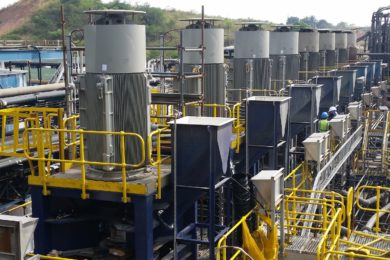An ultra-fine grinding (UFG) circuit of eight FLSmidth VXP mills has been successfully optimised at the Barrick-operated Kibali gold mine in the Democratic Republic of Congo. The first four VXP mills were installed in the Kibali gold recovery plant in 2014. Four additional units were added in 2017, in line with changing from dual oxide-sulphide to a full twin-sulphide operation. The decision to install additional mills was also based on the mill performance and the operator’s satisfaction with the original units. This enabled the operator to handle increased concentrate throughput from 1,500 to 2,700 t per day.
According to Thamsanqa Mahlangu, Kibali’s Projects Metallurgist, the UFG mills are a key element of the integrated gold processing circuit. This process includes primary and secondary crushing, primary milling, flotation, ultra-fine grinding, pre-oxidation, intensive cyanide leach, carbon adsorption and elution.
“The addition of the latest four VXP mills was to handle a higher concentrate throughput from converting to twin sulphides,” Mahlangu says. “We conducted extensive test work in collaboration with FLSmidth to optimise VXP performance, to achieve our design recoveries and reduce concentrate leach residues.”
Among the factors addressed by the new configuration was the ability to handle ore variability from different satellite pits, including high iron-stone content in the Mengu ore, he says. This demonstrated the need for additional grinding capacity.
Craig Brickhill, FLSmidth’s Regional Product Line Manager – Comminution, emphasises that VXP mills operate at a power intensity that is higher than low-speed mills, and overlaps that of high-speed mills.
“This allows the VXP mill to be customised to a wide range of grinding applications,” he says. “Lower ore grades and complex minerology are driving demand for more efficient fine grinding. Typically, slurry enters the circuit at 40 to 70 microns in size, and leaves at about 15 to-20 microns, 80% passing values for both.”
Mahlangu explains that the optimisation testwork to evaluate the mills’ performance looked at key parameters such as media filling, feed slurry flowrate, mill speed and grinding assembly configuration. He agrees that it is very profitable to grind as fine as possible, but explains the importance of understanding relationships between grind and recovery, and media wear and disc wear. The latter ensures that the additional revenues to cost ratios are optimised.
Changes to the grinding assembly, for instance, included a move from standard spacing to single spacing of the grinding discs. “There are potential benefits to a single spaced design at higher media fill levels,” Brickhill says. “Power utilisation is improved, due to higher grinding assembly contact with the media mass. Also, there is an increase in the media agitation within the mill due to uniform distribution of the discs in the chamber.”
The result of adding another four VXP mills – and the optimisation process – has been very positive, according to Gustav du Toit, Kibali’s General Manager. “This has been a constructive process of fine-tuning our process for the best possible results,” says du Toit. “Working in close collaboration with FLSmidth has allowed us to find the solutions we were looking for.”
Brickhill highlights that FLSmidth customises its VXP mills to each unique mining application, optimising the performance of the mill and increasing ore recoveries. “Through FLSmidth’s partnership approach with Kibali, our project team was able to deliver these mills within short lead times to allow Kibali to handle the higher concentrate tonnage reliably and efficiently,” he concludes.










